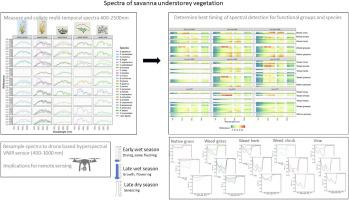International Journal of Applied Earth Observation and Geoinformation ( IF 7.5 ) Pub Date : 2022-07-14 , DOI: 10.1016/j.jag.2022.102870 Kirrilly Pfitzner , Renee Bartolo , Timothy Whiteside , David Loewensteiner , Andrew Esparon

|
The relationship between species phenology and spectral separability is essential to determine the optimal remote sensing sampling period to maximise spectral separability of vegetation species. However, this relationship in many native grasses, introduced grasses and herbs, shrubs, and vine species in tropical savannas is unknown. We measured the in-situ hyperspectral response of monospecific vegetation stands of several understorey species representing different functional groups over phenological stages (throughout dry and wet seasons) using a non-imaging spectrometer. We present a spectral library of both native and introduced species of a tropical savanna environment. We analysed the data using continuum removal to highlight absorption features. Most understorey species displayed a photosynthetic spectral response with increased greenness at the end of the wet season that progressively declined as vegetation dried out. For some species, there were seasonally dependent differences in absorption features with spectral differences between the late wet and early dry season, and late dry and early wet seasons. We resampled the data to the spectral range typical of drone-mounted hyperspectral sensors (i.e., 150 bands between 400 and 1000 nm), which omits the water absorption features of the SWIR. These findings suggest an ideal sampling period for measuring outdoor canopy reflectance of understorey species, which will promote methodological improvements of hyperspectral data capture. The use of a VNIR only hyperspectral sensor will exclude the important regions of the spectrum for plant spectral identification including non-pigment bands for water, nitrogen and cellulose. The results have implications for determining the completeness of rehabilitation assessing reestablishment among indigenous species across mine sites under rehabilitation.
中文翻译:

热带稀树草原下层物种的多时相光谱反射率及其对高光谱遥感的意义
物种物候和光谱可分离性之间的关系对于确定最佳遥感采样周期以最大化植被物种的光谱可分离性至关重要。然而,在热带稀树草原中的许多本地草、外来草和草本植物、灌木和藤本植物中,这种关系尚不清楚。我们使用非成像光谱仪测量了几种代表不同功能组的下层物种在物候阶段(整个旱季和湿季)的单特异性植被林分的原位高光谱响应。我们提供了热带稀树草原环境的本地和外来物种的光谱库。我们使用连续去除分析数据以突出吸收特征。大多数林下物种表现出光合光谱响应,在雨季结束时绿度增加,随着植被变干而逐渐下降。对于某些物种,吸收特征存在季节性差异,晚湿季和早旱季以及晚干和早湿季之间的光谱差异。我们将数据重新采样到无人机安装的高光谱传感器的典型光谱范围(即 400 到 1000 nm 之间的 150 个波段),这忽略了 SWIR 的吸水特征。这些发现表明了测量林下物种室外冠层反射率的理想采样期,这将促进高光谱数据采集的方法学改进。仅使用 VNIR 高光谱传感器将排除用于植物光谱识别的重要光谱区域,包括水、氮和纤维素的非颜料波段。该结果对于确定恢复的完整性评估在恢复中的矿区中本地物种之间的重建具有重要意义。



























 京公网安备 11010802027423号
京公网安备 11010802027423号